Key authentication module¶
The authkey module for GeoServer allows for a very simple authentication protocol designed for
OGC clients that cannot handle any kind of security protocol, not even the HTTP basic authentication.
For these clients the module allows a minimal form of authentication by appending a unique key in the URL that is used as the sole authentication token. Obviously this approach is open to security token sniffing and must always be associated with the use of HTTPS connections.
A sample authenticated request looks like:
http://localhost:8080/geoserver/topp/wms?service=WMS&version=1.3.0&request=GetCapabilities&authkey=ef18d7e7-963b-470f-9230-c7f9de166888
Where authkey=ef18d7e7-963b-470f-9230-c7f9de166888 is associated to a specific user (more on this later).
The capabilities document contains backlinks to the server itself, linking to the URLs that can be used
to perform GetMap, GetFeatureInfo and so on.
When the authkey parameter is provided the backlinks will contain the authentication key as well,
allowing any compliant WMS client to access secured resources.
Limitations¶
The authkey module is meant to be used with OGC services. It won’t work properly against the
administration GUI, nor RESTConfig.
Key providers¶
Key providers are responsible for mapping the authentication keys to a user. The authentication key itself is a UUID (Universal unique Identifier). A key provider needs a user/group service and it is responsible for synchronizing the authentication keys with the users contained in this service.
Key provider using user properties¶
This key provider uses a user property UUID to map the authentication key to the user. User
properties are stored in the user/group service. Synchronizing is simple since the logic has
to search for users not having the property UUID and add it. The property value is a generated
UUID.
UUID=b52d2068-0a9b-45d7-aacc-144d16322018
If the user/group service is read only, the property has to be added from outside, no synchronizing is possible.
Key provider using a property file¶
This key provider uses a property file named authkeys.properties. The default user/group service
is named default. The authkeys.properties for this service would be located at
$GEOSERVER_DATA_DIR/security/usergroup/default/authkeys.propeties
A sample file looks as follows:
# Format is authkey=username
b52d2068-0a9b-45d7-aacc-144d16322018=admin
1825efd3-20e1-4c18-9648-62c97d3ee5cb=sf
ef18d7e7-963b-470f-9230-c7f9de166888=topp
This key provider also works for read only user/group services. Synchronizing adds new users not having an entry in this file and removes entries for users deleted in the user/group service.
Key provider using an external web service¶
This key provider calls an external URL to map the authentication key to the user. This allows GeoServer to integrate into an existing security infrastructure, where a session token is shared among applications and managed through dedicated web services.
The web service URL and some other parameters can be specified to configure the mapper in details:
| Option | Description |
Web Service URL, with key placeholder |
the complete URL of the key mapping webservice, with a special placeholder ({key}) that will be replaced by the current authentication key |
Web Service Response User Search Regular Expression |
a regular expression used to extract the username from the webservice response; the first matched group (the part included in parentheses) in the regular expression will be used as the user name; the default (^\s*(.*)\s*$) takes all the response text, trimming spaces at both ends |
Connection Timeout |
timeout to connect to the webservice |
Read Timeout |
timeout to read data from the webservice |
User/Group Service |
the user group service from which to retrieve the User details when performing authentication |
The mapper will call the webservice using an HTTP GET request (webservice requiring POST are not supported yet), replacing the {key} placeholder in the configured URL with the actual authentication key.
If a response is received, it is parsed using the configured regular expression to extract the user name from it. New lines are automatically stripped from the response. Some examples of regular expression that can be used are:
| Regular Expression | Usage |
^\\s*(.*)\\s*$ |
all text trimming spaces at both ends |
^.*?\"user\"\\s*:\\s*\"([^\"]+)\".*$ |
json response where the username is contained in a property named user |
^.*?<username>(.*?)</username>.*$ |
xml response where the username is contained in a tag named username |
Once the username is extracted, the configured User/Group Service will be used to load the User with roles. Synchronizing users with the user/group service is not supported by this mapper.
AuthKEY WebService Body Response UserGroup Service¶
When using an external web service to get Auth details, it is possible to define a custom GeoServer UserGroup Service being able to fetch Authorities - aka user’s Roles - and UserGroups from the HTTP Body Response.
The rationale is mostly the same; the custom GeoServer UserGroup Service will apply a rolesRegex - Roles Regular Expression - to the body response - which can be either XML, JSON or Plain Text/HTML - in order to fetch the list of available Authorities.
From the retrieved list of Authorities a list of Roles and UserGroups will be created.
It is worth mentioning that this UserGroup Service will always translate fetched roles in the form ROLE_<ROLENAME> and GROUP_<ROLENAME>.
For example if the rolesRegex retrieves this authorities from the response my_user_role1, another_custom_user_role, role_External_Role_X, GeoServer will create:
- The following List of Roles:
- ROLE_MY_USER_ROLE1
- ROLE_ANOTHER_CUSTOM_USER_ROLE
- ROLE_EXTERNAL_ROLE_X
- The following List of UserGroups:
- GROUP_MY_USER_ROLE1
- GROUP_ANOTHER_CUSTOM_USER_ROLE
- GROUP_EXTERNAL_ROLE_X
Each Role will then be mapped to the corresponding Group:
ROLE_MY_USER_ROLE1 <> GROUP_MY_USER_ROLE1
ROLE_ANOTHER_CUSTOM_USER_ROLE <> GROUP_ANOTHER_CUSTOM_USER_ROLE
ROLE_EXTERNAL_ROLE_X <> GROUP_EXTERNAL_ROLE_X
In order to configure an AuthKEY WebService Body Response User Group Service the steps to follow are the following:
- Login as an
Administrator - Move to
Security>Users, Groups, Rolesand selectAdd newfromUser Group Services
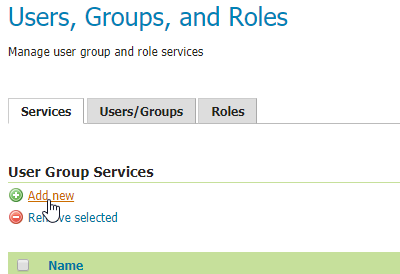
- Click on
AuthKEY WebService Body Response
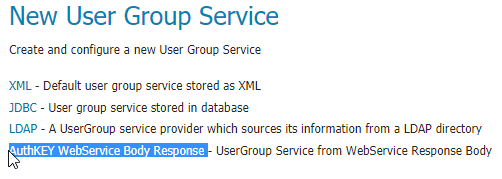
- Provide a
Nameand select anything you want fromPasswords- those won’t be used by this service, but they are still mandatory for GeoServer -
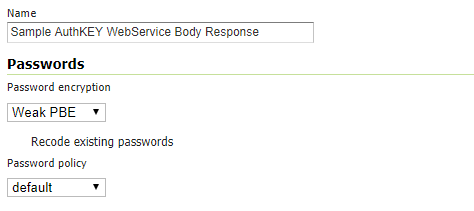
- Provide a suitable
Roles Regexto apply to your Web Service Response
Note
This is the only real mandatory value to provide. The others are optional and will allow you to customize the User Group Service behavior (see below)

Once the new GeoServer UserGroup Service has been configured, it can be easily assigned for usage to an AuthKEY filter.
- From
Authentication>Authentication Filters, select - or add new -AuthKEYusingWeb Serviceas key mapper - Select the newly defined
UserGroup Serviceand save
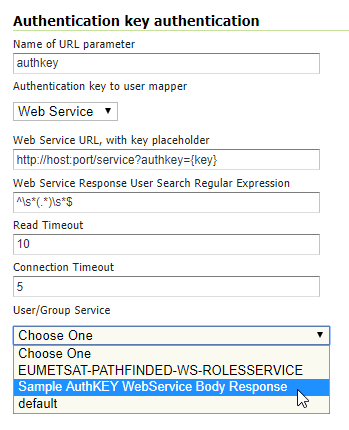
Additional Options
- Optional static comma-separated list of available Groups from the Web Service response
Since UserGroups are not known in advance but only when fetched from the HTTP Response by default it is not possible to map them to interanl GeoServer Roles.
In order to be able to assign any
GeoServer User Groupto other internalGeoServer User Roles, theAuthKEY WebService Body Response UserGroup Serviceallows us to statically specify theGeoServer User Groupsthe Web Service can use; this possible by setting theOptional static comma-separated list of available Groups from the Web Service responseoption: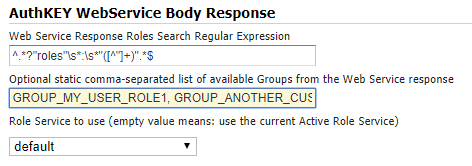
Once this is correctly configured, it will be possible to edit and assign
GeoServer User Rolesto the Groups by using the standard way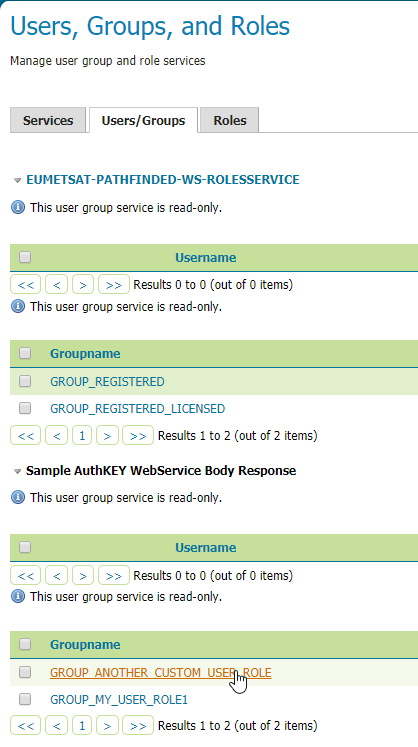
- Role Service to use
By default, if no
Role Serviceis specified, theUserGroup Servicewill use theGeoServer Active Role Serviceto resolveGeoServer User RolesfromGeoServer User Groups- as specified above -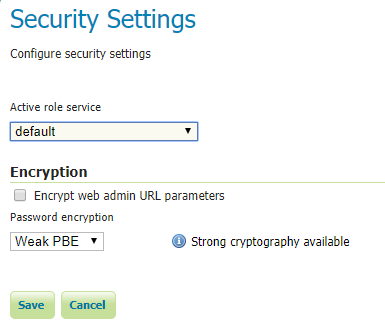
It is possible to define a
Custom Role Serviceto use instead, to resoleGeoServer User Roles; this is possible simply by selecting theRole Serviceto use from theRole Service to useoption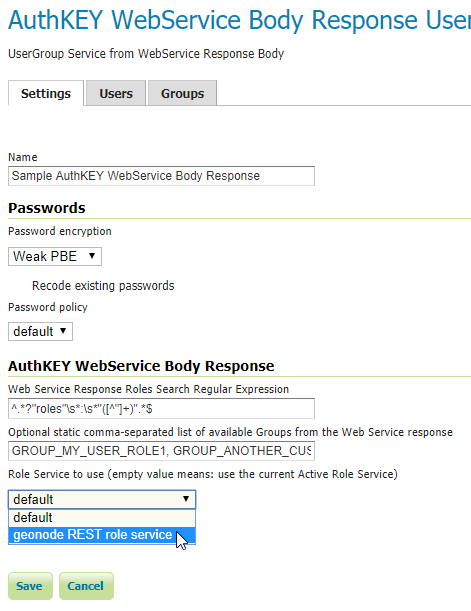
Once the new UserGroupService has been configured GeoServer will authenticate through the AuthKEY filter in the following way:
- The username will be extracted from the HTTP Response.
- The new
GeoServer UserGroup Servicewill be queried to retrieve the User with its Roles. - The new
GeoServer UserGroup Servicewill retrieve the User Roles from the HTTP Response Body and will add them to the list of available User roles. - The new
GeoServer UserGroup Servicewill use the UserGroups retrieved from the HTTP Response Body to load additional Roles for the user.
Configuration¶
Configuration can be done using the administrator GUI. There is a new type of authentication filter named authkey offering the following options.
- URL parameter name. This the name of URL parameter used in client HTTP requests. Default is
authkey. - Key Provider. GeoSever offers the providers described above.
- User/group service to be used.
Some of the key providers can require additional configuration parameter. These will appear under the Key Provider combobox when one of those is selected.
After configuring the filter it is necessary to put this filter on the authentication filter chain(s).
Note
The administrator GUI for this filter has button Synchronize. Clicking on this button saves the current configuration and triggers a synchronize. If users are added/removed from the backing user/group service, the synchronize logic should be triggered.
Provider pluggability¶
With some Java programming it is possible to programmatically create and register a new key to user name mapper that works under a different logic. For example, you could have daily tokens, token generators and the like.
In order to provide your custom mapper you have to implement the org.geoserver.security.AuthenticationKeyMapper
interface and then register said bean in the Spring application context. Alternatively it is possible
to subclass from org.geoserver.security.AbstractAuthenticationKeyMapper. A mapper (key provider) has
to implement
/**
*
* Maps a unique authentication key to a user name. Since user names are
* unique within a {@link GeoServerUserGroupService} an individual mapper
* is needed for each service offering this feature.
*
* @author Andrea Aime - GeoSolution
*/
public interface AuthenticationKeyMapper extends BeanNameAware {
/**
* Maps the key provided in the request to the {@link GeoServerUser} object
* of the corresponding user, or returns null
* if no corresponding user is found
*
* Returns <code>null</code> if the user is disabled
*
* @param key
* @return
*/
GeoServerUser getUser(String key) throws IOException;
/**
* Assures that each user in the corresponding {@link GeoServerUserGroupService} has
* an authentication key.
*
* returns the number of added authentication keys
*
* @throws IOException
*/
int synchronize() throws IOException;
/**
* Returns <code>true</code> it the mapper can deal with read only u
* user/group services
*
* @return
*/
boolean supportsReadOnlyUserGroupService();
String getBeanName();
void setUserGroupServiceName(String serviceName);
String getUserGroupServiceName();
public GeoServerSecurityManager getSecurityManager();
public void setSecurityManager(GeoServerSecurityManager securityManager);
}
The mapper would have to be registered in the Spring application context in a applicationContext.xml
file in the root of your jar. Example for an implementation named com.mycompany.security.SuperpowersMapper:
<?xml version="1.0" encoding="UTF-8"?>
<!DOCTYPE beans PUBLIC "-//SPRING//DTD BEAN//EN" "http://www.springframework.org/dtd/spring-beans.dtd">
<beans>
<bean id="superpowersMapper" class="com.mycompany.security.SuperpowersMapper"/>
</beans>
At this point you can drop the authkey jar along with your custom mapper jar and use it in the
administrator GUI of the authentication key filter.
